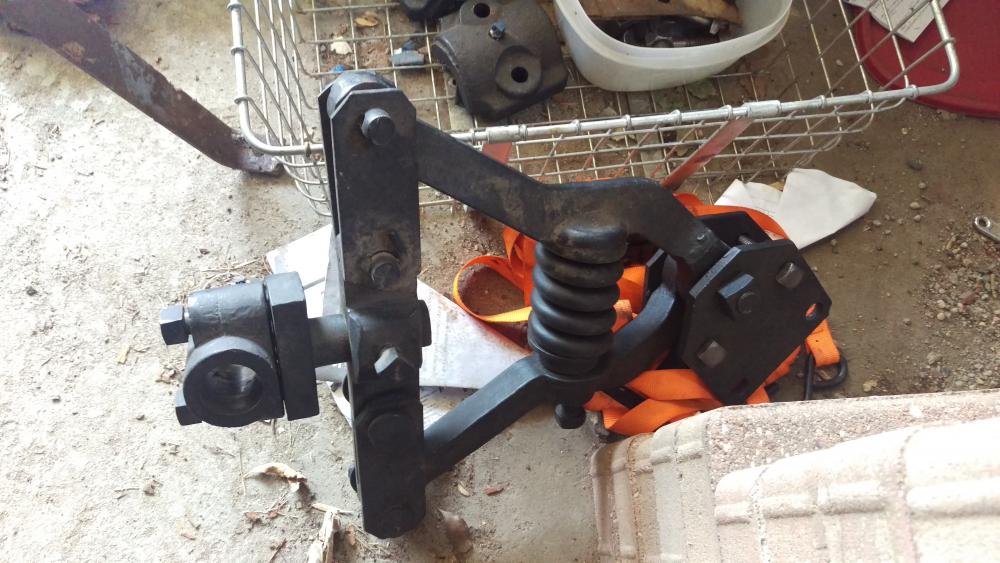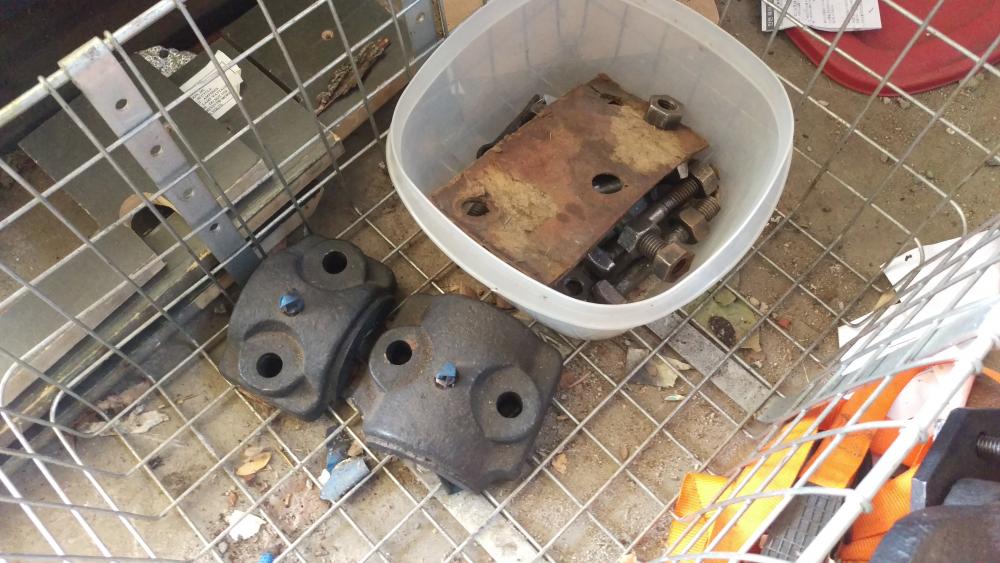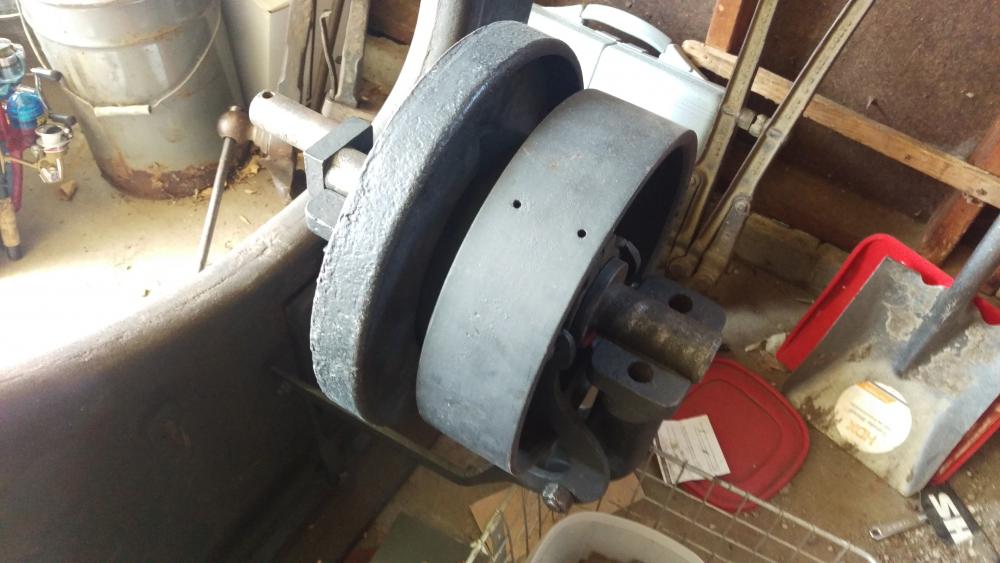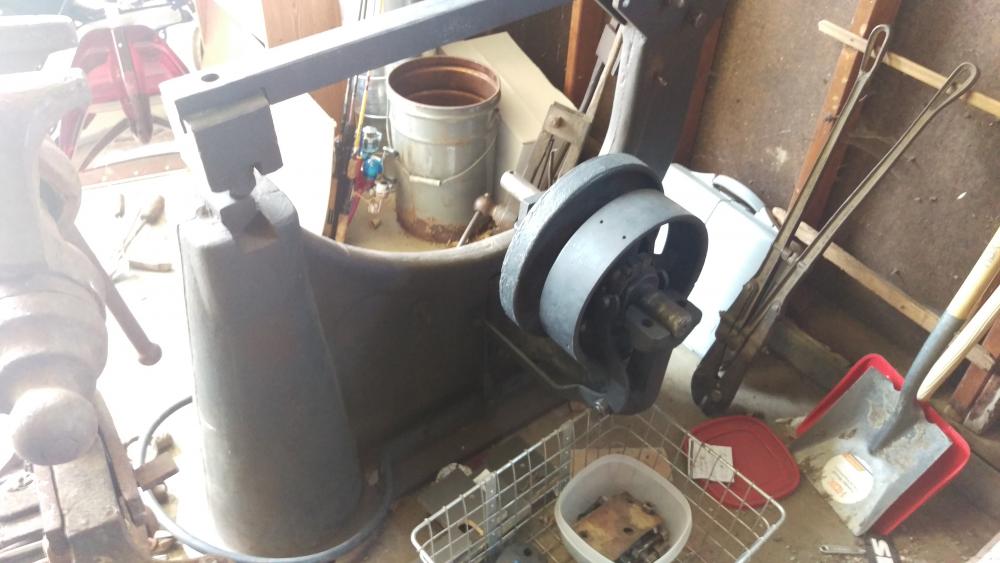
Twilight Fenrir
Members-
Posts
50 -
Joined
-
Last visited
Profile Information
-
Location
Iron, MN
-
Interests
Blacksmith
Recent Profile Visitors
The recent visitors block is disabled and is not being shown to other users.
-
Actually, here's a question for you then... If you stumbled onto a working, good conditioned Easy Helve that you wanted to restore, what would you be willing to pay for it? I'm just trying to get a ballpark on what the thing is actually worth... I'm talking with the seller about trading some of the extra junk I've got laying around, so maybe that will help...
-
Good to know thank you! I've never done work with babbit, but I have a friend who has a good deal of experience working on his Little Giants who would be more than happy to help if I need it. You are correct, there is no motor, it has never been hooked up to anythong but the original line shaft. I have a literal pile of electric motors though, so I'm not concerned about that.... I do have a motor related question though, does the HP of the motor really effect a power hammer much? My aforementioned friend uses a little half-horse motor on his 25lb, and I think a 1/2 horse on his 50lb little giant as well, and they seem to work fine? I have a 2 horse motor I had earmarked for my 1890s 30" bandsaw, but I think I'm going to sell that saw, so it could easily find its way onto the helve instead if it needs a bigger motor...
-
Yep, that was my assessment as well. I knew Hercules anvils were made by Haybudden when I saw it, and who could mistake that shape?!? It's got an unusual crease in the middle of the face that runs from one side to the other can't figure out what is going on there, but I think this anvil will replace my 250lb Peter Wright as my main shop anvil. There are one or two deep gouges, but they're smaller than 1/4" around, and the face, even covered in rust, has excellent rebound. I'll have to take a wire wheel to it this wekend to get a better look at it.
-
Wow, that's a pretty little hammer! Have you ever used it? Isn't it adjusted the same way as the Little Giants, by moving the spring arms up and down the little vertical shaft on the back of the eccentric? (the left-most component in the very first picture I posted, has a shaft that sticks up into the little butterfly, has one bolt that tightens it around the shaft) My memory is fuzzy, but I want to say that was called a Dupont mechanism?
-
Are you referring to the spring+arms? Because that actually IS what the Easy-Helve used... Gosh, looking at these things... I really want one XD They're so cool looking! So unlike anything else out there, yet so obviously related to the Little Giant... It really is a very simple machine. And I would imagine that having that manner of spring would help it give a more uniform striking pattern than most other helves.
-
I'm having a very hard time finding any information on this thing... I guess the seller was telling the truth when he said only 400-500 of these things were made. The only Helve hammers I can find information on are home made affairs, or giant machines of industry... This is a really interesting link though.... http://www.abana.org/ronreil/Forge1.shtml#An I think I could be pretty happy with this hammer actually, it's just a matter of what it's really worth...
-
Driving by the scrap yard I live next to today, I felt something calling to me... so I swung on in and walked around, looking for a power hammer as I do every now and then.... and what should I find, but a 260 lb Hercules Anvil being used to hold down a pile of sheet metal Asked the owner how much, and we agreed on $200 for it. I mentioned my smithing, and fished out my box of wares to give him a bottle opener in gratitude, and he really liked one of my RR Spike knives, so he took that, and $160 for the anvil n.n The bird poop next to the hardy hole was free...
-
Not trying to refute either you or the seller, just looking for some clarification... the seller stated that the swing COULD be adjusted for stock thickness, but that it was a chore to do. Usually meaning people set it at one place for life, and deal with it... I mostly work with smaller stock at the moment, so that wouldn't be the end of the world I guess... but, that lack of flexibility IS important to know. I'm guessing you can't use top tooling, because it doesn't come down perfectly straight, so it wouldn't work terribly well? I'll try to look up other pricing examples of helve hammers to show him and see if the price will come down a bit, and do a bit more research to see if it's a good tool for me... but I really appreciate your information, you gave me some real points to think about!
-
Hello there, I posted a wanted add for a power hammer on CL, and one of the replies I got back was for a Mayer Bro's Helve Hammer, which I understand is sort of the prototype for the Little Giant. I don't know much about Helve hammers, so I thought I would seek out input from the better informed... I understand thr mechanical difference between a helve, and a trip hammer, but what I don't know is how the different design affects the work it does. I've used a 50lb Little Giant, and a 25lb as well, but never a Helve Hammer. The obvious thing to do would be to ask to go try it out and see how it works, but it is disassembled, so that's not really an option. The seller seems to be very competent, and understands what he's talking about, so I think he is very credible. He's asking for $1,700 which is within my price range. He tells me it uses a lot of the same parts as the Little Giants, so despite being an odd duck, it's relatively easy to maintain... He did say that it probably needs a new clutch pads, but otherwise all the parts are there, and it should be bolt together, shim, and go. (not all parts are pictured, just a few shots) The first question I'm sure will be, "what type of work do you want to do with it?" The answer to that is pretty general blacksmithing. I don't really have a niche, I make knives, and I make decorative items. So far everything I do is relatively light stock, but that's partly why I'm looking for a power hammer so the heavier work is more managable. I'd love to be able to make some hammers... Does anyone else have some more insight to share on this? Thanks!
-
just joined... looking at a vulcan anvil?
Twilight Fenrir replied to 927xpert's topic in Anvils, Swage Blocks, and Mandrels
Very true! The extra mass of an anvil increases your gravitational effect on other anvils dramatically... In my experience, people either have no anvils, or 3+ anvils Over the last month, I've suddenly started practically tripping over the things! The more I buy, the easier it is to find them! -
just joined... looking at a vulcan anvil?
Twilight Fenrir replied to 927xpert's topic in Anvils, Swage Blocks, and Mandrels
$255 seems pretty reasonable if your guess on the weight is accurate. I've only seen #80, #100, and #200 Vulcans, so I'm not familiar enough with the in-between sizes to speculate based solely on appearance. I did my first two years of blacksmithing on a Vulcan anvil in MUCH worse shape than that. And even after I switched over to my new Peter Wright, I still sold my 200# Vulcan for $400, again, in MUCH worse shape, very easily. Almost anything remotely anvil shaped is worth at least $2/lb. Anvils are a good investment, and hobby-smithing is becoming more and more popular... Prices on anvils are going up fast, you'll almost always be able to get back what you pay for one if you don't go bonkers. There's absolutely nothing wrong with a Vulcan anvil. Yes, they are made out of cast iron, but they do have a steel face, and that's what counts. Actually, cast iron anvils have a few benefits that their wrought iron kin lack. Firstly, they are quiet. Having gone from that 200lb cast iron Vulcan to my 250lb forged wrought iron Peter Wright, I do miss the gentle "thwack" vs the loud ring whenever I work on the horn... the ring has it's own charm... but, I digress.... Furthermore, wrought anvils have a tendency to develop a swayback over their 100+years of service life. This is something that does not happen with cast iron, as it is does not deform nearly as easily as wrought iron. -
Right?!? Well, I have a needle scaler I inherited from my Grandfather, from his days at the mines.... it's a pretty serious looking tool... I've never used it, or even hooked it up though... That's where I got my cutting torch too, which is rated for cutting 9" of steel with the right tip... I could almost cut that anvil in half height-wise in one pass with that baby (Not that I EVER would!) That torch is probably still my favorite tool... very handy in blacksmithing. You're probably right... but I'm kind of stubborn in a lot of ways. I've got a good solid idea of what I want to do, and I don't mind throwing the time and 20lbs of rod at it... Besides, it's good practice, and I need more excuses to put hours onto my stick welding.
-
I would love to use my MIG welder... but I'd have to grind it out further to accept the big nozzle on my MIG gun... With the stick welder I just have to be able to get the stick in there Goodness, that was certainly a very detailed response, thank you! I highly appreciate your input. I understand what you mean about grinding the opposite sides... but for some reason I just can't fathom doing it that way XD I trust the original welds about as far as I can throw the anvil... literally.... I'm pretty sure if I throw the anvil the weld will break I'm hoping it does, anyway. Otherwise I'll cut through the weld to the crack so I can start from scratch. Would love to use my MIG welder, but I'd have to have a steeper angle to get the nozzle down in there. Plus, I only have 100%CO2 available at the moment. Well, it's a high enough stress area that the anvil broke in half there Granted, it was probably an imperfect forge weld that did it in, but the Haybudden style anvil has a REALLY narrow waist. Working on the horn, or on the heel would put a lot of stress in that area... though, you're right, probably not enough to break 1/2" of weld all around it... But what WOULD be an issue, is the two surfaces in the core of the anvil wouldn't meet perfectly. Without it being solid to the core, you're taking away from the efficiency of the anvil, as some energy is going to be lost there.
-
Oh, I did round off the edges before putting it into use. That wasn't /quite/ a finished picture... The anvil is big enough that I left a bit of sharp edge back towards the heel so I could use it when I needed to (Actually needed to do so today, making some specialized tongs) but otherwise it's mostly smoothed out. To be fair, that anvil was basically a yard ornament when I got it. There was an entire edge broken away, it was horribly swaybacked, and had 1/4" deep chisel cuts into it. The lovely thing about metal is, it's just like painting... If something goes wrong, you can always strip it down, and do it again! If this repair doesn't last forever, it can be ground down and welded with something else! Maybe by then I'll have a bigger shop and better tools. But for now, it's working great, much better than I thought it would. There is something to be said for "Good enough"



